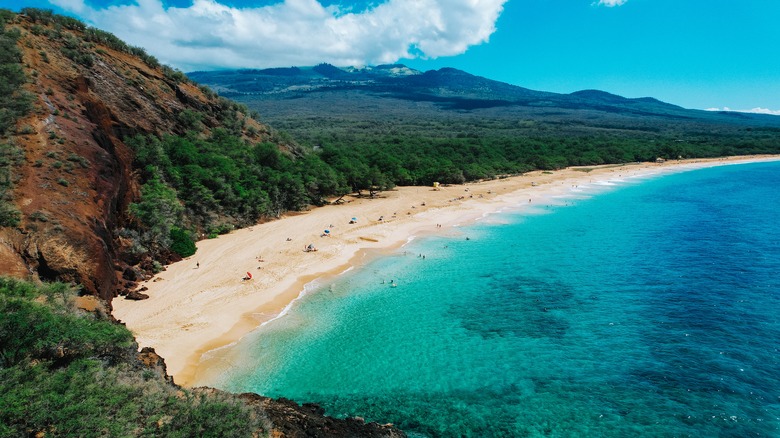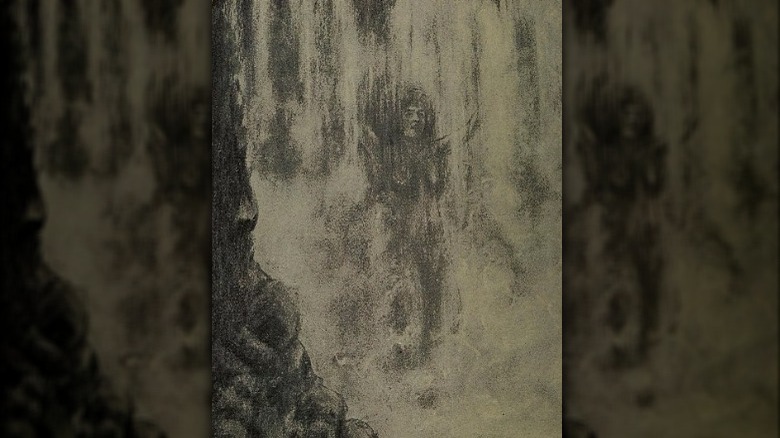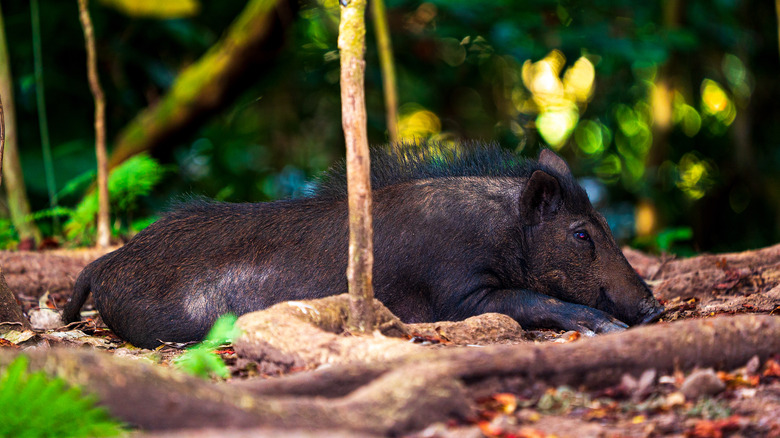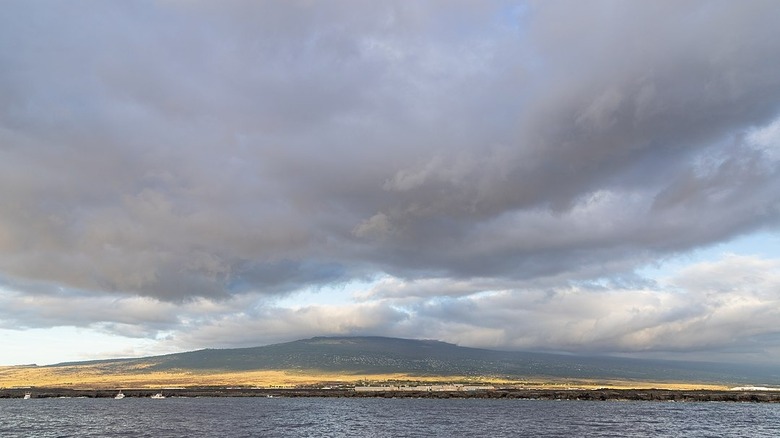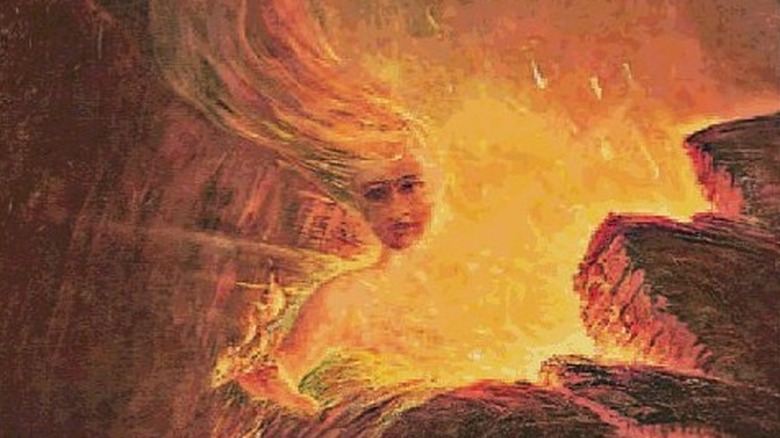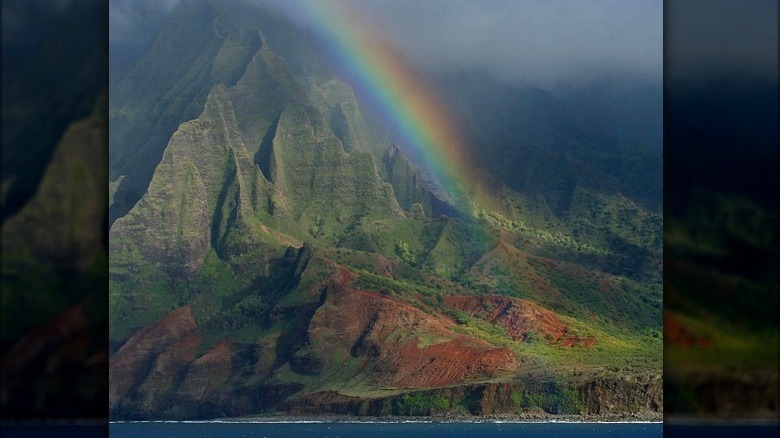The Hawaiian Legend Of Pele And Kamapua'a Explained
Many teens who lament about their rough childhoods rebel by staying out past curfew, hanging out with the wrong crowd, talking back to their parents, running away, or maybe dyeing/styling their hair in some unnatural way. But most victims of an unnurturing upbringing probably wouldn't shave their hair into short bristles, cover their body head-to-toe in black tattoos resembling pigskin, and sport the demeanor of an angry, vengeful hog while embarking upon a lifelong plunderous rampage (via Coffee Times).
The child, or rather, Demi-God, who had this reaction would grow up to fall in love, only to lose said love and rage so greatly that two climates could exist on one island (via Love Big Island). This is the story of the hog-child, how he came to be, and the pain he had to endure to live out the story (which, like many legends, is just one of numerous versions of the story). It all started when he was born, when from the very start, he felt unloved. But love and acceptance were all he ever truly wanted, and the hog-like rage he was known for only worsened the more he craved what he couldn't have.
The birth of a hog-child
Kamapua'a, known as the hog-child or Hog God in Hawaiian folklore, was born to Hina (via Coffee Times), Goddess of motherhood, the moon, ocean, fishing, and food-bearing plants (via Papahana Kuaola). While who his mother was is certain in most versions of the tale, who his father is differs from story to story. Many believe he was born to Chief Olopana, Hina's true husband, others believe he was born to the chief's younger and more handsome brother, Kahiki-ula, who Hina was known to be fond of (via National Park Service).
Hina spent a lot of her free time with Kahiki-ula, going berry-picking and discussing herbs. She noted the differences between him and his aging brother, to whom she was legally and matrimonially bound, but she still regularly invited Kahiki-ula on private excursions. Olopana resented the friendship, but did nothing, as he did not know the two were actually having an affair. And some believe that affair resulted in a son.
How he got his name
When Hina gave birth to a son, his alleged father, Chief Olopona, would not accept him as his own (via Coffee Times). Suspecting the unsavory relationship between his wife and brother, he told Hina that Kahiki-ula could raise the child as his own, and dubbed the eventual Demi-God Kamapua'a, roughly translated as Hog-Child. Despite his cruel name, Kamapua'a grew up to be attractive and healthy, with God-like gifts bestowed upon him by his mother's divine lineage. His eyes shone black, and he had a strong personality, but he was not always the angry deity he became known to be. One of his God-like skills was to change his appearance, which he would eventually use to imitate a hog.
His gifts and appearance only caused who he believed to be his father, Olopona, to hate him more, when all he wanted was to be wanted and loved. Eventually, Kamapua'a ran away, jaded, with a spite-filled soul. He did not know why his father would not love him, so he took to the hills. There, he persuaded a group of a few dozen young men to help him rampage through Olopona's kingdom, destroying everything in their path. Around this time is when he altered his appearance. Somewhat of a self-fulfilling prophecy, his cruel name took form. He shaved his head, tattooed his skin, and created a cloak for himself out of the hide of a wild hog, with the furry side up.
The revenge of Kamapua'a
After months of plundering his father's (or maybe uncle's) kingdom, he was captured by Olopona's people (via Coffee Times). But thanks to his divine charm and former ties with allies in the kingdom, he was released. Before leaving his former home again, he murdered the cruel man he once called father. After this heinous crime, Kamapua'a traveled to Maui, where his mother now lived, engaged to his uncle (or possibly father). But upon arrival, Kahiki-ula, his uncle (or possibly father), declared he did not know him, and did not claim him as a son.
With this heartbreak went the last of Kamapua'a's humanity. He plundered and killed without restraint, said to possess both the anger and lust of a wild hog, attacking women wherever he went. He even began to shape-shift to resemble a wild hog during these plunders, proving himself to be the true "hog-child" his illegitimate father believed him to be.
The love of Kamapua'a
Kamapua'a once traveled through a fertile valley between Waipio and Pololu on the Big Island during his plunders (via Coffee Times). He ventured south towards the crater of Kilauea, as he had heard of a beautiful group of sisters (and their brothers) who settled there. Among the girls, Pele was said to be the most beautiful. Pele had a fiery temperament, matching only Kamapua'a's, which made sense as she later became known as a volcanic deity or goddess in Hawaiian folklore (via National Park Service).
Upon laying eyes on her, Kamapua'a fell desperately in love. Yet, now possessing the rugged appearance of a vicious wild hog, Pele had no interest in him. In some stories he sang to her, and in others he begged her to be his wife, but in disgust, she called him a pig, and the son of a pig. With a broken heart, yet again not understanding why he could not just be loved — the only thing he ever wanted — he did what he did best: rampage. In Kamapua'a's rejection-fueled battle against Pele, some say the wild hog tried to drown her, while others say he ate her whole family only to release them from his stomach in guilt (via National Park Service). And then there are those who say Kamapua'a became one with the goddess, even only for a brief moment.
The tragedy that created climates
Kamapua'a called upon the gods of storms and rain to seek wrath on Pele, but Pele, who looked to the power of fire for defense, explained that if she was drowned, he could never have her (via Coffee Times). To that he retorted that if she were to burn him in defense, she would starve without the fertility his rains brought. At this stalemate, the two embraced as lovers, and some say it was the only time Kamapua'a ever felt whole. Confused by the uncharacteristic love Kamapua'a showed her, Pele retreated, telling her once lover that he could reign upon the eastern valleys of Hilo, Hamakua, and Kohala. There, he could keep them wet and fertile, while she kept her western side of the mountain warm and sunny.
Although Pele ran from Kamapua'a, he searched for her endlessly, only retreating to the sea when he saw the volcanoes she created erupt. Pele eventually grew to miss him, and seasons later, bore his son, Opelu-nui-kauhaalilo. To this day, Kamapua'a is said to reign from the ocean, protecting the pigs of Kohala and abundance of life in Hawaii, by roaming its many waterfalls. Many scientists believe the arid climate found on the western side of the Big Island is caused by mountains blocking the humid, ocean wind from the east, the same wind that makes the eastern mountainside rainy and fertile (via Paradise in Hawaii). But maybe, just maybe, it was the doomed love of two deities that created Hawaii's landscape as we know it.
